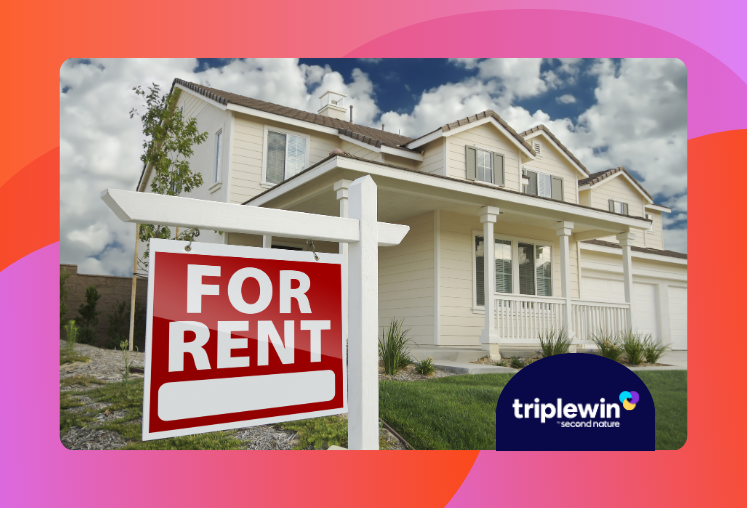A study by McKinsey found that the main factor behind up to half of purchasing decisions is word of mouth. A successful referral can set up your property management company for the long term. A bad referral can lead to stress, late nights, and overwork.
So how do you nail a good referral program?
We sat down with an expert to get some answers. Jim Roman is the Director of Results at Business Owners Institute, LLC, and a speaker and coach well-known in the property management industry. Jim helped us talk through the best practices for getting referrals, how to build a (legal) referral program, and how to follow through for success.
Key Learning Objectives:
- What you need for successful property management referrals
- How to optimize the referral process
- What your program goals should be
- How to promote referrals
- How to track referrals and their success
- How to maintain and nurture your referral relationships
Meet the Expert: Jim Roman, Director of Results at Business Owners Institute
Jim Roman founded Business Owners Institute 18 years ago to help business owners and their teams make more money, have more time, and – most importantly – have a life beyond their business. He coaches leaders from many industries and has a strong client base in property management. From a course called “How to Double Your Income in 90 Days,” his work has grown into a nationwide coaching and consulting business.
Essential components of successful property management referrals
A property management referral program is a marketing strategy that incentivizes your current clients to refer new clients to your PMC and grow your doors. Referral marketing is one of the best ways to grow a quality client list in any business. But in the property management business – where relationships and word of mouth still reign supreme – referral marketing is an essential strategy.
A relationship-based approach
Roman urges property managers to keep local laws and regulations in mind when discussing a referral “program” rather than casual referral strategies:
“A referral program would be that you get compensated for referrals,” Roman says. “You have to be careful in the property management industry when you do this kind of stuff. The laws are different throughout every state. For example, in Virginia, you’re required by law to give two to three people when asked about a realtor or realtor referral program.”
Roman urges that a relationship-based, win-win approach – over a referral fee – is far more effective for long-term outcomes. He has coached hundreds of companies on how to build a successful, relationship-based referral strategy.
Defined target audience
A defined target audience is critical to the success of your relationship-based referral marketing. Roman outlines three key audiences for getting referrals:
1. Current clients
According to Roman, the average investor has two to three property management relationships with many rental properties. You may not even know about those other properties if you don’t have a strong relationship with their investor.
“One of the things I teach my clients to do is what I call an Owner Outreach Program,” Roman says. “Reach out to the property owner, check in on them and how they're doing. Tell them ‘We're not asking for money and there's nothing wrong with your property. I just wanted to check in and find out where your goals are for this year.’ Next thing you know, they go, ‘Well, it's funny you should call. I have a couple of properties I want to give to you.’”
2. Past clients
The next strategy for your target audience is to check in with past clients.
“You might check in with them and see how they're doing,” Roman says. “They might say, ‘Oh, it's funny you should call me. I'm not happy with my property manager. I should never have left you.’”
He adds that if they are happy with their current arrangement, they likely won’t pick up the phone when you call anyway – “so you have nothing to lose.”
3. Strategic partners
Roman says, “Think about people who have databases that you would want where partnering with them could be very profitable.”
The number one source of business for property managers is real estate agents. After that, Roman lists CPAs, investment advisors, and estate planning attorneys.
"If someone passes away," Roman says, "and someone else inherits some properties, who's going to know that? The CPA, the investment advisor, or the estate planning attorney.”
Achievable goals for referrals
The next factor is to set achievable goals for your referrals. Roman advises his clients to identify between six to eight referral partners to refer clients.
“It only takes three technically, but you don’t know which of the six to eight will be your three,” Roman says. “If one quits, you’re down, losing a third of your referrals.”
He advises a strategy to focus on the three target audiences above – current clients, former clients, and strategic partners. “I might have three relationships in each category,” Roman says. “Not all are going to refer you. But the key is that you can answer if someone asks you for a CPA, etc. Then, eventually, those partners will start returning the favor and referring you a lot of business.”
A clear referral reward system
Roman says that the best rewards systems offer incentives. but also give people options. He shares an example of a referral program he promoted.
“It was a March Madness referral program,” Roman says. “For the month of March, if you refer us any clients, you get a choice of one of three things: $250 credit towards coaching in the future, $100 gift card to your favorite restaurant, or $100 to your favorite retail store.”
The power in that is it’s giving you options, which helps ensure you’ve hit on something that each person might want.
Note: Again, remember to follow your local laws.
A marketing strategy to promote your referral program
According to Roman, the key to any marketing strategy is to bring awareness to the fact you are looking for referrals.
“This is important,” Roman says. “Some people think you’re doing so well you don’t need it. But who doesn’t want new business?”
Romans says that he sends a survey at the 90-day mark of getting a new client and asks, “How are we doing?” Then, they add the question: “What could we do to make it easier for our clients to refer us?”
“One woman said, ‘I just need a flier,’” Romans says. “That was so easy!”
The RISEE method: 5 steps to optimize referral conversions
Next, Roman walked us through the steps to optimize the referral process. He advises his clients to use the RISEE process: build Relationships, Identify opportunities, Strategize, Execute, and Evaluate.
Step 1: Build Relationships (R)
At this point, it should come as no surprise that the “r” is for “relationships” – the most important part of any referral plan.
Roman says, “One of the questions I love to ask people is how they got into their industry and what they enjoy most about their business. You're going to find a connection and build that relationship.”
He also warns that how you approach is key. “You don’t say, ‘Let’s get together to see how we can help each other out.’ You should be trying to identify what is a good referral for them. So you should say, ‘I would love to learn about how we would be able to refer you and see if it’s something we can partner on.’ It’s about them, not you.”
Step 2: Identify opportunities to refer (I)
That leads us to the next step: Identify opportunities to refer – both for them and for you. Roman says it’s important to get very specific here. For example, if you’re working with a realtor, don’t just go with “they’ll take anybody looking to buy a house.” For your own referrals, be clear on what property management services you’re offering.
Roman says, “That's not specific enough. Is someone upsizing? Downsizing? Is it a half-million-dollar house? A million-dollar house? Another way I go about this is I'll ask them to give an example of some of the types of clients they’re working with now.”
“This identifying step takes some time,” Roman adds. “The whole process should not happen in one sitting.”
Step 3: Strategize on how to do it (S)
Roman says the key here is to identify what has worked before.
“So when I ask how I should refer someone, they always give a sales answer. They'll give you the words that they would say if they were in front of the prospect. But you're not a salesperson for them, so you can't do it that way.”
Instead, says Roman, “I might say, ‘What are different ways people have referred you in the past?’ Rarely does anybody ever ask that question, but it makes the strategy part so much easier.”
Step 4: Execute that action (E)
This is all about holding up your side of the bargain. Once you’ve identified opportunities and built a strategy for both of you to refer to each other, you need to actually execute.
“Tell them, ‘I want to commit to giving you at least one referral by this month,’” Roman says. “And that's important because usually if I really want a referral relationship, I have to give first. A lot of times, people say, ‘Okay, this was great. I'll figure out how I can help you.’ Yeah. You're not gonna help me, you're gonna forget about me.”
Instead, commit yourself to a goal and timeline so your partner knows you’re serious. Roman suggests a script like: “Okay, I’m looking to refer you in the month of April, and I'm going to work on getting you one referral. Is that okay with you?’”
They’re going to say yes.
Step 5: Evaluate how it went (E)
“A lot of times there is no evaluation,” Roman says. “But the second E is the power in this whole process – debriefing, training me to know what worked. I need to learn.”
“Ask ‘What would be better,’ rather than just asking, ‘Is this going okay?’” Roman recommends.
Without following up, you can easily lose that referral to another relationship. Roman says he’s seen it happen time and again. Follow-up and evaluation are critical to generating more referrals.
We’ll share more on evaluating your program below.
6 ways property managers promote referral partnerships
Remember that when it comes to referrals, your state’s laws may have strict requirements on what is allowed. Keep those legal restrictions in mind. However, in terms of building referral partnerships and strategies, you can follow several paths to promoting your plan.
Create a dedicated referral program landing page
Again, people don’t know you need referrals unless you tell them. Create a landing page for your website that’s simple, clear, and lets people know exactly how to refer you.
Use social media
Reviews, likes, comments, and more on social media are one of the best ways to get word of mouth out there. (You can join Second Nature’s Facebook group of active, supportive property managers.)
Send email marketing campaigns
Once you’ve identified your target audience of current clients, former clients, and strategic partners, you can build email campaigns targeted specifically to each.
Sign strategic partners for cross-promotion
Strategic partners are any businesses that have a database that could add value to your company. As Roman outlined above, the best partners for property managers are real estate agents, CPAs, investment advisors, and estate planning attorneys.
Remember: To get referrals, let people know you want referrals!
Use hyperlocal advertising campaigns
This is so simple but so effective.
Roman says, “I always recommend going out to real estate offices on a frequent basis. Bring donuts or bagels or offer to do a real estate sales meeting and buy breakfast. Make it frequent, not just one and done.”
It’s about relationships and being the first PMC that comes to mind the next time they’re asked for a property manager referral.
Track referral program performance: metrics that matter
This brings us back to the second “E” in RISEE – evaluation. According to Roman, this is the most overlooked but important part of the process.
Here are his tips to track and build upon your referral success.
Track best-converting referral sources
The key here is talking to your referral partners about your definition of a good referral, a better referral, and the best referral. “In referral relationships, we don’t always talk about that,” Roman says. “What’s a good referral? What’s a bad referral?”
In property management, he says, a bad referral would be someone who is not flexible with their property management team and management agreement, won’t let you make any changes, etc.
By contrast, Roman says, “A great referral will be an investor who says, I don't care, just get it done. I trust you. You're the expert.’ A middling referral might be the landlord who has a personal attachment to the investment property and wants to know what's going on on a regular basis. It's profitable, but it's not like the investor is ready to say, ‘I trust you, you're the expert.’”
So the key here is to track which types of referrals you get that most quickly convert into profitable clients. Then let your referral partners know exactly what that client looks like.
Optimize the referral program based on your partnerships
Set your success metrics for your referral program and optimize your program based on reasonable goals.
“First is setting your referral goals,” Roman says. “How many referrals are you hoping to get on a monthly basis?”
Decide how many referrals per month you want from each of your strategic partners.
“An average door, let’s say, could be worth $2,000 of revenue a year for a property manager,” Roman says. “So if I get three realtors giving me all three referrals, that's $6,000 of revenue to the company. Plus the first month's rent if you charge something like that. So I would wanna have a referral goal and then monitor how many I'm getting from all my partners.”
The goal, too, is to be sure you’re getting as many referrals as you’re getting.
Maintain strategic referral partnerships for long-term growth
All of this is pointless, Roman says, if you aren’t nurturing those relationships.
“It's important that you stay in touch with the person you’re referring and the person you’re referring to,” Roman says. “This is a team effort, not an individual effort.”
Similarly, when you receive a referral, let the referring partner know how it’s going. Let them know if it was successful and how you’re nurturing that referral. They’re more likely to continue referring people to you if they know you’ll really follow through and take care of that person.
Tiered reward system for best performers
If you’ve built a reward system (within legal boundaries), consider creating tiers for the highest-converting referrals. Companies do this all the time with employee referrals. Set up rewards that correspond with the stages of growth or future sales with that referral.
Do they convert into clients? Do they last over six months or a year or multiple years? Thank your referral partners by gifting them rewards for these milestones. This practice also helps to highlight for them what a good vs. better vs. best referral looks like for you.
Understand what’s working by talking to your top-performing referral program partners
Roman shares an example of how to really invest in those referral relationships.
“I was working with a staffing firm where the boss was one of my top three referral partners. She told me, ‘If you can help Tracy, you'd be helping me.’ I said, ‘Consider it done.’ So I would get together with Tracy at least once a month for a cup of coffee to give her resumes. And she’d go, ‘Oh, thanks, Jim.’ And that was it. Six months into it, something told me to ask her, ‘Are these good referrals?’ She says yes, yet again. So instead, I asked, ‘Tracy, what would be a better referral for you?’ She had an answer: ‘Oh, a better referral would be orders. Resumes are great, but when companies give me an order, and they want me to place the person, that’s the best thing you could do for me.’ Within weeks, I came across a company that was looking to fill an order. I hooked them up with Tracy and followed up afterward. She told me it was the biggest deal of her career.”
Roman says it’s critical to ask not just “Is this going okay?” but “How could it be better?” Again, that helps you nurture and understand their needs, and it’s likely they’ll return the favor.
Property management referral program best practices: expert recommendations
Okay, let’s review all we’ve learned from Jim Roman and make one last list of best practices. Here are some best practices for property management referral programs:
- Offer a valuable incentive: A strong incentive can motivate your existing clients to refer new business. Roman says, “A strong incentive from my experience is doing a great job for the referrals received. If you are going to give them monetary incentive, give them options.”
- Keep it simple: Make it easy for clients to refer others by providing them with a simple and streamlined process. This could include a referral form or a unique referral link that they can share with others. Ask for this from your partners, as well.
- Communicate regularly: Keep your clients informed about your referral program by communicating regularly via email or newsletters. This will keep your program top of mind and increase the likelihood that clients will refer others.
- Leverage social media: Use social media to promote your referral program and encourage clients to share it with their followers. This can help you reach a wider audience and generate more referrals.
- Follow up quickly: When a new referral comes in, follow up with them quickly to show that you appreciate the referral and are excited to work with them. Follow up with both sides.
- Track results: Keep track of the referrals you receive and the incentives you offer. This will help you assess the success of your program and make adjustments as needed.
In the end, it’s all about building meaningful, effective partnerships that benefit everyone in the long run.
Get more property management tips, insights, and expert advice in our Second Nature Community.
FAQ
What is a property management referral program?
A property management referral program is a marketing strategy that incentivizes current clients, past clients, and strategic partners to refer new property owners to your company. These programs can include formal incentive structures or relationship-based approaches that reward referrals through gifts, credits, or reciprocal business arrangements.
Are referral fees legal for property managers?
Referral fee regulations differ significantly across states. Some states prohibit unlicensed individuals from receiving compensation for property management referrals, while others allow it with specific disclosures. States like Virginia have mandatory referral disclosure requirements. Always verify your state's specific regulations before implementing a paid referral program.
Who are the best referral partners for property managers?
The most valuable referral partners for property managers are real estate agents, CPAs who work with real estate investors, investment advisors with high-net-worth clients, estate planning attorneys handling inherited properties, and real estate attorneys involved in transactions. These professionals regularly interact with property owners needing management services.
How do I promote my property management referral program?
Promote your referral program through a dedicated landing page on your website, social media campaigns, targeted email marketing to current and former clients, cross-promotion with strategic partners, and hyperlocal advertising like bringing breakfast to real estate offices. The key is making sure people know you want referrals.
What incentives work best for property management referral programs?
The most effective incentives offer options to appeal to different preferences. Examples include credits toward future services, gift cards to restaurants or retail stores, or non-monetary rewards like event tickets. Relationship-based approaches focused on reciprocal referrals often outperform one-time monetary incentives for building long-term referral partnerships.
Topics:






